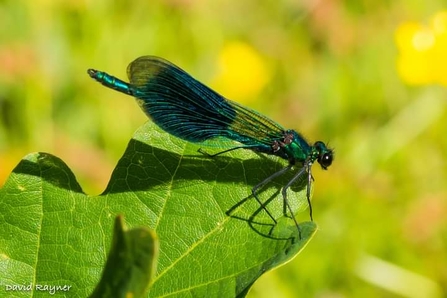Ponds and pools are important to many animal species, but I always associate them with our spectacular dragonflies.
With their bright colours and impressive wingspans, dragonflies are an integral part of a heathland. Dragonflies were around long before the dinosaurs, with some prehistoric dragonflies having wingspans of 70cm! The insects we have on the reserve are somewhat smaller than that, the largest reaching a more modest 10cm.
Dragonflies have four obvious wings, which they hold wide open when sitting at rest. There is a group of dragonflies called the damselflies, which are much more delicate, and these fold their wings behind them when they land. Of course there are always contradictions to this rule, with the willow emerald damselfly sitting with its wings at a jaunty 45 degrees.
When in flight, they are among the fastest and most manoeuvrable of all insects. A big dragonfly can whizz around at 36km/h, and because each wing is controlled independently, they can stop in mid-air, move sideways, or even backwards. They use this manoeuvrability to catch insect prey in mid-air. Many of the large dragonflies will carry on flying while they eat their meal – ready to catch the next mouthful.
Dragonflies spend a lot of time around water, because they lay their eggs in or near water, which then hatch to produce stumpy, wingless larvae. These larvae spend up to three years under water feeding on other aquatic insects, tadpoles and even small fish. When they are ready to emerge, they climb out of the water onto stems of vegetation and a fully grown adult will squeeze out of the larvae’s abandoned skin.
Dragonflies seem to like heaths and bogs. In fact, about a third of all British dragonflies live exclusively on heathlands. The soil and water are very acidic, which means that there are not many fish to eat the young dragonflies – the pools also tend to stay warmer, which speeds up growth.
Over 17 species of dragonfly are known to hunt or breed on the reserve, and include the banded demoiselle with it’s metallic blue body and big blue/black band on its wings, the keeled skimmer, found nowhere else in Kent, and the emperor, which, as the name suggests, is one of Britain’s biggest! This year our surveyor Rob Insall has found a colony of the beautiful demoiselle, a species similar to the banded demoiselle, but with solid black wings.

©️ David Rayner
For more information about dragonflies, the work of the Kent Wildlife Trust, and how you could get involved...
Dragonflies | Wildlife Explorer

